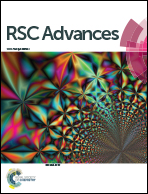The art of the possible: computational design of the 1D and 2D materials based on the tetraoxa[8]circulene monomer†
Abstract
Novel one- and two-dimensional π-conjugated materials containing a tetraoxa[8]circulene monomer are designed on the basis of density functional theory techniques, including the periodic boundary condition for the infinite structures. These new materials are predicted to be the perspective ambipolar organic semiconductors showing a high mobility for hole and electron charge carriers. Furthermore, we demonstrate that the extension of π-conjugated tetraoxa[8]circulene units in the second dimension leads to a material with the HOMO–LUMO gap being significantly smaller than that for the 1D polymer ribbon. This fact clearly indicates the fundamental difference between the designed 1D and 2D semiconducting polymers, which constitutes the essence of modern “band-gap engineering”. The consistent growth of π-conjugation determines the strong visible light absorption of the studied systems in a great contrast to the initial lack of color of the tetraoxa[8]circulene compound. The possible chemical routes to synthesize the predicted materials are discussed, including free Gibbs energy estimation for the proposed reactions.
![Graphical abstract: The art of the possible: computational design of the 1D and 2D materials based on the tetraoxa[8]circulene monomer](/en/Image/Get?imageInfo.ImageType=GA&imageInfo.ImageIdentifier.ManuscriptID=C4RA02693D&imageInfo.ImageIdentifier.Year=2014)

 Please wait while we load your content...
Please wait while we load your content...